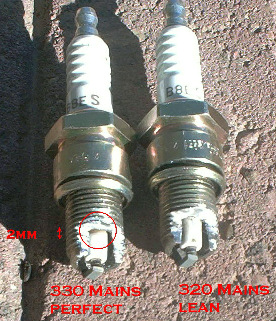|
How to read spark
plugs
Thanks to Boonman
What is a ”plug
chop”?
A plug chop is one way to verify your main jet jetting. To do a plug chop,
make sure the air filter is clean, warm up the motor, shut it off and
install new spark plugs. Start the motor and pin the throttle, running
through all gears. When you wind out the top of top gear, hit the kill
switch and pull in the clutch. Keep the throttle pinned!
Remove the spark plugs (put in the old ones to get home if necessary)
and put one in a vise. Using a hacksaw, cut the threads away from the
center electrode with one cut parallel to the electrode and one cut
perpendicular to the base of the electrode, so you can see the very base of
the center electrode.
What will I see?
-
If your
main jets are spot on, you will see a 2mm tall chocolate-brown colored
ring at the base of the electrode.
-
If the
ring is taller than 2mm or darker than a Hershey bar, you’re rich on the
mains.
-
If the
ring is smaller than 2mm or lighter, or nonexistent, you’re lean on the
mains.
-
If both
plugs aren’t almost identical, one cylinder may be richer or leaner than
the other (if leaner then an air leak is likely on that cylinder).
Keep in mind that doing a plug chop is best used as a way to verify your
mains. While it’ll cost you a couple bucks for new plugs, the plug chop - if
done correctly - is the single best way to find out if your mains are dialed
in for your current mods, temperature, and elevation.
How do I read my spark plugs?
Aside from doing a plug chop, you can read your spark plugs to get an idea
of your overall jetting (to see the base of the center electrode you'll
still need to either cut the threads away or use an illuminated magnifying
glass). You’ll need to ride for at least 30 minutes to get a reading, but
once done you can find out about your overall jetting, ignition timing, and
spark plug heat range. Be advised that it’s not a good idea to ride around
when you know it’s way too lean or rich, and remember that unless the
throttle is held at a constant position the jetting indications on the spark
plug are an "overall" idea; one circuit can be rich and can mask a lean
circuit.

-
You set
your heat range from the ground strap (this is the piece closest to the
piston)
-
You do
all the plug readings for jetting from the base ring (the base ring is
what the ground strap is welded to at the end of the threads)
-
You
determine detonation and timing issues from the porcelain The porcelain
shows preignition/detonation, it will NOT accurately determine jetting
(air/fuel ratios)
Do NOT base jetting
decisions on the porcelain color at the tip!
How to determining plug heat range
The ground strap is your window to getting this right. If the "color" of the
ground strap "changes" too-close to the ground strap's end, (the end
opposite of the base ring), then the heat-range is "too-cold" (heat transfer
is too quick to the base ring). If the "color" of the strap changes near
where it is welded to the base-ring, then it means that the plug heat-range
is "too-hot" (heat transfer to the base ring is to slow causing the deposits
to be burned off the strap completely). The strap at this point could start
working like a "glow-plug", probably resulting in pre-ignition and/or
detonation. The properly set heat-range is when the "color" is at the
half-way point on the strap.
Reading the base ring to determine jetting
The base ring "color" is very close to the color of the piston crown and is
used to determine the jetting. You're looking for the soot color to be a
nice light to medium brown, (color is always hard to describe) if the color
doesn't go all the way around the base ring (at least one full thread turn
on the plug) or the color is whitish it is way too lean. If the color goes
all the way around, but there is a spotting of heavy dry soot on the top of
the color, you are too rich.
Read the porcelain to determine detonation/preignition
The first signs of detonation/preignition will be seen on the porcelain down
in the plug, It shows up as tiny black or shiny specks of aluminum. Also
look very close around the center electrode where the porcelain intersects,
this will appear to be melting between the insulator and the electrode.
Detonation is caused by the air/fuel mixture exploding rather then burning.
This gives off a sound (a knock), this sound is the result of a shock wave,
this wave disrupts the boundary layer of cooler gases that cover the
internal parts of the combustion chamber. This causes a very rapid rise in
pressure and temperature. The results are holes in the top or sides of the
pistons, blown head gaskets, broken rods (all bad stuff), this can also
shock the rings from their seal causing oil to form as little spots on the
porcelain.

Perfect
Too lean
More reading on the subject...
And more...
|


